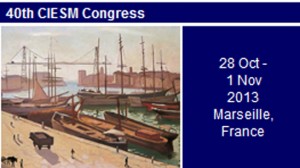
La semaine du 28 octobre 2013, Florian Holon et Julie Deter participeront au 40eme congrés CIESM à Marseille. Plus d’infos sur le colloque sur http://www.ciesm.org/marine/congresses/index.htm
Résumés des 2 communications ci-dessous :
Species richness and anthropogenic pressures in French coralligenous assemblages
Holon F.1,2, Mouquet N. 2, Doxa A. 2, Boissery P.3, Deter J.1,2
1Andromède océanologie ; 2Université Montpellier 2 ; 3Agence de l’eau RMC.
Abstract: Coralligenous concretions are biogenic reefs built by sciaphilic algae and animal builders. The resulting patchwork of complex micro-habitats and species present richness, biomass and productivity equivalent to tropical reefs. Hard to reach with classical diving methods, coralligenous concretions are poorly studied in comparison to their high ecological importance. RECOR is a monitoring network (Agence de l’eau RMC / Andromède océanologie) surveying coralligenous concretions at 120 stations along the French Mediterranean coast since 2010. We present here the first results concerning the totality of the 120 stations.
We are interested in the link between anthropogenic pressures and species diversity distribution.
Assessment on 90 years of coastal development in France. Which impacts on Posidonia oceanica beds?
Deter J.1,2, Guilbert A.1, Freschet E.1, Boissery P.3, Holon F.1
1Andromède océanologie ; 2Université Montpellier 2 ; 3Agence de l’eau RMC.
Abstract: Posidonia oceanica is a Mediterranean seagrass. Highly sensitive to environmental changes, it is used as an indicator of coastal water quality. Upper limits (0 to -15 m) of P. oceanica beds were mapped from historical (1920) and present aerial pictures. The comparison shows that upper limits are essentially stable (85 %) and regression (13 %) are mainly due to coastal artificialisation (65 %).
